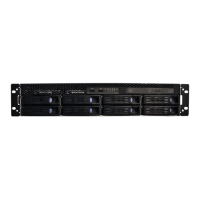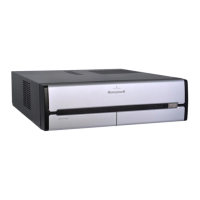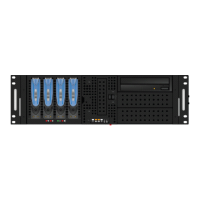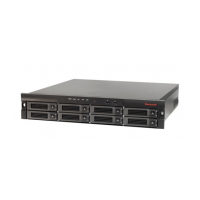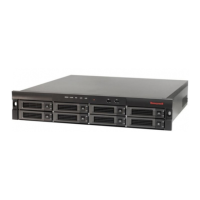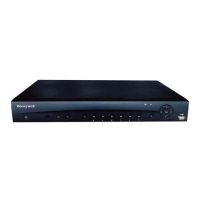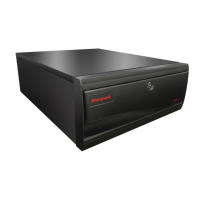
Do you have a question about the Honeywell MAXPRO NVR Series and is the answer not in the manual?
| Category | DVR |
|---|---|
| Model | MAXPRO NVR Series |
| Network Interface | Gigabit Ethernet |
| Operating System | Embedded Linux |
| Video Outputs | HDMI, VGA |
| Power Supply | 100-240 VAC, 50/60 Hz |
| Operating Humidity | 10% to 90% (non-condensing) |
| Video Compression | H.265, H.264 |
| Recording Resolution | Up to 4K |
| Remote Access | Yes (via web browser or mobile app) |
| Hard Drive Support | SATA HDD |
| RAID Support | RAID 0, 1, 5, 10 |
| Audio Input/Output | Yes |
| Alarm Input/Output | Yes |
| Operating Temperature | 0°C to +40°C (32°F to +104°F) |
General warnings and safety instructions for installation and servicing.
Detailed safety instructions covering reading instructions, cleaning, attachments, ventilation, power, lightning, and servicing.
Information on product warranty, repair/replacement policy, and contacting technical support.
Explains various symbols that may appear on the NVR, such as WEEE, UL, and FCC compliance.
Introduces the guide's purpose: procedures for installing, configuring, and using the MAXPRO NVR system.
Specifies the target audience for this document as field and commissioning engineers.
Outlines the guide's coverage of installation and configuration for various MAXPRO NVR solutions.
Describes the detailed structure and contents of each chapter within the guide.
Lists documents that serve as prerequisites for understanding MAXPRO NVR.
Explains the typographical conventions used throughout the guide for clarity.
Introduces the MAXPRO NVR line, its solutions, channel support, and key features.
Highlights key features differentiating MAXPRO NVR from other IP video surveillance systems.
Lists new services and features introduced in the NVR 5.0 release.
Explains the support for up to 128 channels in NVR Software and PE RAID System, including licensing.
Details Anonymization support to comply with EU GDPR standards, including masking techniques.
Describes a privacy protection feature requiring two people to authenticate for playback operations.
Outlines improvements to password security, including complexity requirements and expiry.
Mentions rearrangement of features in the Systems tab for better user experience and accessibility.
Lists improvements in metadata handling, recording file system, and backward compatibility.
Highlights a quick 3-click wizard for system setup, auto-configuration, and camera discovery.
Explains the feature to configure and store recordings at camera level, synchronized back to NVR viewer.
Supports mobile monitoring clients on iOS and Android for viewing live video, playback, and managing alarms.
Explains commissioning as the process of setting up NVR hardware, installing software, and configuring the system.
Outlines the phases of commissioning: system setup, software installation, configuration, and verification.
Covers determining system requirements, choosing architecture, connecting monitors, and keyboards.
Details the software installation process for server and client computers.
Describes configuring Honeywell cameras via wizard, system settings, disk management, schedules, and user administration.
Explains checking surveillance operations like live video, pan/tilt/zoom, and recording to verify configuration.
Introduces the chapter's focus on settings for setting up the MAXPRO NVR system.
Guides on setting up the MAXPRO NVR unit and client computers as the first phase of commissioning.
Illustrates the MAXPRO NVR SE system diagram as a typical example.
Depicts the MAXPRO NVR Hybrid system diagram as a typical example.
Instructions on connecting local monitors to the MAXPRO NVR unit.
Provides steps to power on the MAXPRO NVR unit and the initial login process.
Explains how to change the pre-configured IP addresses and machine name of the NVR unit.
Step-by-step instructions to change the IP address of the network adapter.
Instructions on how to change the computer name and update it using the utility.
Details recommended display settings and how to configure them via context menu or control panel.
Guides on setting up the MAXPRO NVR server and client computers.
Describes rear panel connectors for Hybrid XE, SE, and PE models.
Explains how to connect various video sources like DVD players, VHS players, and CCTV cameras using BNC connectors.
Instructions on connecting Honeywell UltraKey joystick controllers to MAXPRO NVR via Ethernet.
Introduces the chapter on procedures for installing MAXPRO NVR software.
Advises to meet hardware and software specifications before installation.
Lists the required operating systems for MAXPRO NVR Server and Client workstations.
Recommends creating a separate partition for Metadata storage on a non-OS hard drive.
Explains how Windows updates affect installation and the need for rebooting if pending.
Recommends disabling defragmentation before installation and provides steps to do so via GUI and Registry.
Advises to turn off system protection for all drives to prevent potential issues during installation.
Recommends creating a new administrator account and disabling the default one for installation.
Guides on completing the MAXPRO NVR software installation by following specific sections.
Step-by-step instructions for installing MAXPRO NVR, including setup validation.
Provides instructions to perform a full installation, including selecting the installation type.
Details the installation of the Web Client component and the MaxproWEBConfigurator utility.
Explains the option to install MAXPRO NVR Client on client workstations.
Explains how MAXPRO NVR server addresses are saved in profiles and how to select or set a default profile.
Provides instructions for logging on to MAXPRO NVR, including default credentials and recommendations.
Offers tips for logging on, including language selection, Windows authentication, and profile settings.
Guides on changing the default password and creating a new one before logging in.
Covers managing profiles, saving server addresses, setting default profiles, and editing ports.
Instructions on how to save server addresses in profiles, modify, and delete them.
Explains the feature used for Internet clients to connect to a particular NVR in a private LAN by defining rules in the router.
Introduces the user interface, its components like tabs, tree-structures, status bar, and icons.
Describes the Viewer tab and its components, including devices, alarms, snapshots, and layouts.
Explains the Configurator tab's role in system setup, camera configuration, and device management.
Details how to search for recorded video and events using the Search tab.
Describes the Report tab for generating Event History and Operator Log reports.
Covers general settings, OSD settings, frame rates, and video rendering options.
Guides on viewing software version and license information through the User menu.
Instructions on how to log off from MAXPRO NVR using the User menu.
Steps to close the MAXPRO NVR user interface via the User menu.
Introduces the chapter on configuring MAXPRO NVR, covering system setup, IP address, devices, users, and roles.
Guides on configuring Honeywell cameras using the MAXPRO NVR Wizard, a three-step procedure.
Discusses firewall settings, noting they are pre-configured for boxed solutions and automatically configured for software-only solutions.
Covers system-level settings, event recording, email, archival, edge sync, site info, and holiday/exception settings.
Helps configure disk settings for saving recorded video, automatically adding available drives.
Explains that cameras are video input sources and can be added as IP or Analog cameras.
Guides on automatically discovering and adding Honeywell IP cameras and encoders, or manually adding supported cameras.
Describes default settings and configuration options for cameras.
Guides on adding multiple streams for a single camera, depending on camera model.
Explains discovering and adding third-party ONVIF and AXIS cameras, noting model name display and "ONVIF DEVICE" type.
Instructions to manually add FLIR cameras, including specifying IP address, port, and model.
Explains configuring RTSP cameras/encoders by specifying the RTSP URL and settings.
Guides on configuring IP camera inputs and outputs, connecting them to devices like motion detectors or door openers.
Details configuring Panomorph settings for Immervision-compatible cameras to enable 360-degree FOV.
Guides on manually connecting analog cameras and adding/deleting them in the Camera page.
Explains VMD for configuring motion detection, defining regions of interest, and differentiating real motion from noise.
Guides on configuring built-in VMD using the Camera Web Client, enabling zones and setting sensitivity.
Instructions on how to modify camera settings like name, IP address, type, and advanced settings.
Defines schedules for continuous recording and video analytics, with default schedules provided.
Explains user roles and privileges for performing operations like viewing video, reporting alarms, and surveillance tasks.
States that verifying configuration is the final phase to ensure MAXPRO NVR is working correctly.
Advises to ensure that the configuration of MAXPRO NVR is complete before proceeding.
Lists checks to perform using the MAXPRO NVR UI, such as connection, camera listing, live video, and playback.
Guides on checking the connection by logging on to the MAXPRO NVR server using client computer profiles.
Verifies that the Devices window in the Viewer tab correctly lists connected and discovered IP cameras.
Explains how to acknowledge and clear alarms listed in the Alarms window, which notifies operators of events.
Instructions to check live video from cameras to ensure they are connected and functioning properly.
Guides on checking recorded video playback using the timeline or bookmarks, ensuring recording settings are configured.
Details performing panning and tilting on live and recorded video using the digital PTZ feature.
Explains how to save a frame of video as an image in various formats and view them.
Guides on creating clips from recorded video, saving them with digital signatures for authenticity.
Describes a salvo layout customized by operator preferences, allowing saving of frequently used camera views.
Explains how operators can search for recorded video from cameras, filtering by conditions like date and time.
Describes generating event history and operator log reports for devices and user activities, exportable in various formats.
Introduces the chapter on upgrading MAXPRO NVR software, covering various upgrade scenarios.
Details the supported upgrade paths to MAXPRO NVR 5.0 Build 509 Rev D from previous versions.
Step-by-step instructions for upgrading to NVR 5.0 using the setup DVD or setup.exe.
Guides on upgrading to MAXPRO NVR 4.9 Service Pack by running the setup executable.
Details the supported upgrade paths to MAXPRO NVR 4.7 Build 188 from previous versions.
Instructions for upgrading to MAXPRO NVR 4.7 Service Pack by running the setup executable.
Details the supported upgrade paths to MAXPRO NVR 4.5 Build 162 from previous versions.
Details the supported upgrade paths to MAXPRO NVR 4.1Build 123 Rev B from previous versions.
Details upgrade support from MAXPRO NVR 3.1 SP1 or later to MAXPRO NVR 4.0.
Recommends performing database backup before the upgrade process using MAXPRO NVR Agent.
Step-by-step instructions for upgrading to MAXPRO NVR 4.0 using the setup DVD or setup.exe.
Introduces the MAXPRO NVR Web Client for remote access and video surveillance via web browser.
Explains limitations of anonymization and four-eye authentication in the Web Client.
Details the default installation of the Web Client and MaxproWEBConfigurator utility.
Lists prerequisites for Web Client access, including Silverlight and supported web browsers.
Guides on setting up the MAXPRO Web Configurator for System, Server, and Security configurations.
Guides on creating a self-signed certificate required for accessing NVR server using a domain name via HTTPS.
Steps to install the certificate in Internet Explorer for accessing the web client without errors.
Guides on changing the default HTTP port 80 and HTTPS port 443 on the MAXPRO NVR.
Guides on verifying certificate details by checking the server machine information and certificate details.
Introduces connecting to MAXPRO NVR via mobile app, covering installation, user creation, and daily tasks.
Lists enhancements in NVR 5.0 release, including new mobile app versions and supported OS.
Details the minimum requirements for the MAXPRO NVR Mobile app, including device compatibility and internet connection.
Shows a typical system setup and guides on configuring port forwarding on the router.
Guides on creating non-Windows users in NVR to allow access from authorized mobile device users.
Guides on adding the MAXPRO NVR to the mobile app for viewing video.
Instructions on how to edit saved NVR recorder details, including swiping and selecting Edit or Delete options.
Steps to delete saved NVR recorders, including a warning message and confirmation.
Explains the chapter's focus on mandatory security settings for MAXPRO NVR.
Recommends creating new Administrator and Service User accounts and changing the default ones.
Detailed steps to create a new Windows user account with administrator privileges.
Guides on creating a user within the MAXPRO NVR application's User tab with the new account details.
Steps to create a new service user and deny local logon for it.
Instructions to update NVR services with new service user account credentials by stopping and configuring services.
Guides on updating application pool identities and physical path credentials in IIS Manager with the new service account.
Steps to disable the default Administrator account and the NVRTestUser account.
Instructions to restart all NVR services after making security changes.
Guides on copying desktop shortcuts from the Administrator account to the new user account.
Instructions to update task schedule credentials with the new user account for IISRecovery, MaxBootAssistant, and TrinityBackupScheduler.
Guides on enabling remote desktop services and options, with safety precautions.
Guides on changing the default Windows password for the logon user.
Details changing the default password for the NVRServiceUser and related MAXPRO NVR Services.
Describes creating secured network connections using IPsec policies for secure video data transmission.
Lists supported antivirus software and provides guidance on auto-protection and updates.
Warns against scheduling hard disk scans on DATA drives to prevent performance degradation.
Explains creating a rule for Special Exception on Windows Server and Client Machines.
Outlines improvements to password security, including complexity requirements and expiry.
Provides guidelines for secure installation, connection, and access to MAXPRO NVR.
Covers customizing IP address, machine name, and setting up scheduled metadata and database backup.
Describes creating scheduled tasks for daily, weekly, or monthly metadata and database backups.
Guides on creating scheduled tasks for backing up metadata and database based on requirements.
Utility for updating unique ID numbers for cameras, retaining data during failover operations.
Guides on enabling the Video on Demand feature by modifying the registry and restarting services.
Provides image stream combinations for Oncam Grandeye Evolution cameras, including resolution and best fps.
Covers VMD setup, including event-based recording, server VMD, and built-in VMD settings.
Guides on configuring camera settings for VMD-based recording, including built-in and server-based VMD.
Refers to Server VMD section for SMART VMD information.
Guides on configuring built-in VMD using the Camera Web Client, enabling zones and setting sensitivity.
Adjusts VMD configuration for optimum results, including identifying areas and selecting regions of interest.
Describes various default event and alarm types with severity levels for cameras, recorders, and SMART VMD.
Guides on configuring Loitering & Intrusion Trace Alarms by upgrading firmware and configuring alarms.
Explains discovering and configuring AXIS cameras/encoders using ONVIF compliance.
Guides on enabling ONVIF Web Service on AXIS devices for discovery.
Lists patches released for MAXPRO NVR 4.0 and explains enhancements and fixed issues.
Details the AXIS Patch, its version, installation, and the issues fixed.
Describes the Skylake Patch, its version, installation, and release highlights like processor support and archival deletion schedules.
Lists issues fixed in the Skylake Patch, including Sandy-Bridge, I18N, Clip Player, Axis v6.0, and GPU driver issues.
Guides on increasing the limit for rendering cameras by modifying the registry.
Steps to disable the GPU Rendering feature from the Preferences dialog box.
